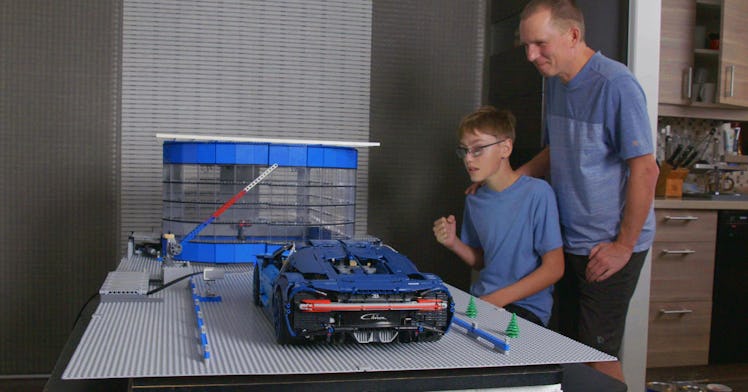A DIY Garage Worthy of the New LEGO Bugatti Chiron
A father and son wanted a space worthy of the new LEGO Bugatti. So they went ahead and built an LED-lit, 4,821-piece working garage.

This story was produced in partnership with LEGO Technic.
What do you do when you have the sweetest LEGO build on the block? Build it a worthy home. In the case of the LEGO Bugatti Chiron, a 3,599-piece work of art, that means piecing together a stately garage using a pile of LEGO Technic and a ton of ingenuity.
That’s just what Irouri Petoukhov, the mastermind behind the LEGO Technic YouTube Channel The Brick Wall, did with his son. Together, the two took countless hours piecing together a garage worthy of one of the most beautiful LEGO cars ever designed.
Petoukhov knew the minute he put pencil to paper to design the Bugatti’s garage that he wanted to make a memorable construction. “We created a one-story garage with doors that are the same width of the unit while opened,” Petoukhov wrote in his design plans. “It has a rounded front face and doors in the style of the Bugatti horseshoe with a barrier at the entrance. The rear wall will be white with horizontal blue stripes and the sidewalls, doors, and roof will be transparent with blue elements at the top and bottom, allowing spectators to view the Bugatti from the outside.”
He didn’t hold back when it comes to the bells and whistles, decking it out with LED lights that will be installed under the ceiling and a fully-functional automatic door.
The garage itself is made out of more parts than the Bugatti — a whopping 4,821 pieces. Here, Petoukhov broke it down into a simple step-by-step build, so you can DIY your own Technic garage — or just appreciate the process.
Step 1: Build the Foundation
Just like any project, you have to start from the bottom up. The foundation itself is made of 836 pieces — from flat panels for the floor to gear racks and an L-motor to run the door. The walls are made of nine plates that are hinged into clear panels that make up a transparent ceiling, which Irouri designed so you can always see the car parked in the garage.
Step 2: Install the Electronics
Petoukhov had several options when it came to creating a garage door, but he settled on going the extra mile to create an automatic door instead of a manual door. To pull off an automatic door, he needed the same tech that you probably have in your garage. With an EV3 system, a LEGO MINDSTORMS programming kit, Petoukhov set up four motors and connected four sensors within ten-inches from each other. The wiring is usually the hardest part of any project, and “infared beacon” and “intelligent brick” aren’t normal building materials. To make things simpler, you can buy an EV3 system and follow the directions. But be warned, the door is a little heavy — so you will need a 10-volt transformer and a rechargeable battery to summon the electronic power required.
Step 3: Build the Front Doors
The doors — which are the same width as the unit to create a more spacious look and feel and open out instead of sliding up — pay a special homage to the Bugatti brand. The doors integrate perfectly into the design of the structure, which has a rounded front face and doors in the style of the Bugatti horseshoe. And of course, there’s another sensor-activated barrier at the entrance to keep all the riff-raff toy trucks out.
Step 4: Put on the Bells and Whistles
If you’re feeling successful with wiring and programming thus far, you can take it to the next level like Petoukhov did by installing LED lights into the garage to make it look like a proper Bugatti showroom. He also took LEGO pieces and built out a length of driveway leading up to the garage for extra effect and built a small cable trunk to hide all the wires of the electronic components.
By the time it was finished, Petoukhov had put days into this custom LEGO Technic build. But what he put in with time and effort, he got plenty of STEM learning and bonding (with his son, Michael) out of the build, and experiencing the process of problem solving together — just like you and your kids next time you break out a new LEGO building kit.
This article was originally published on